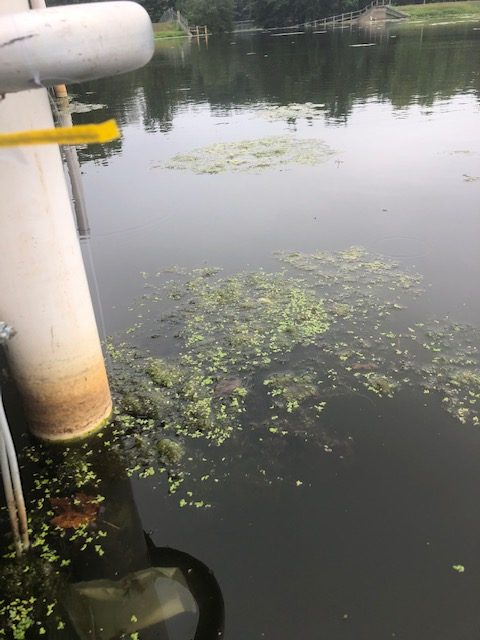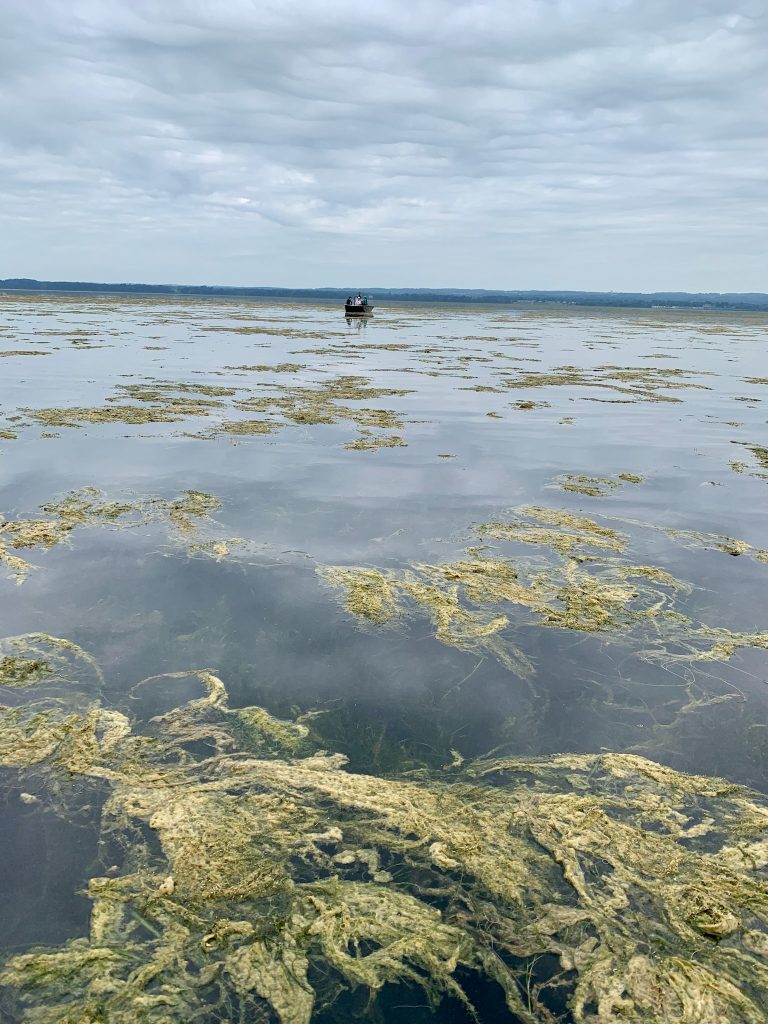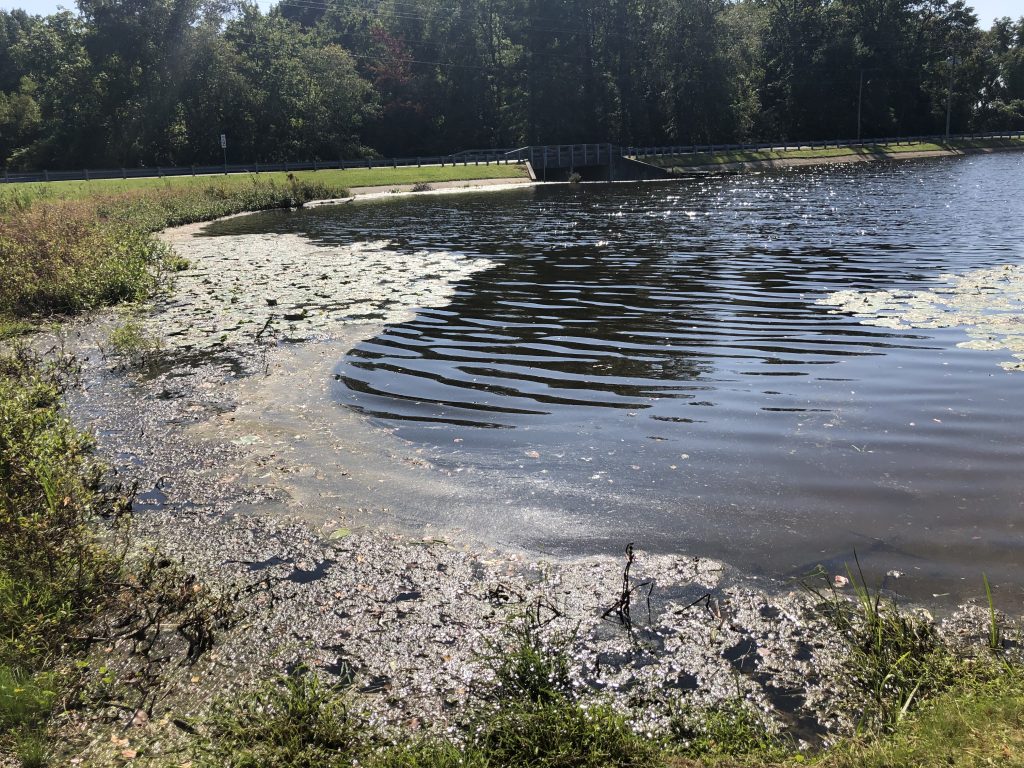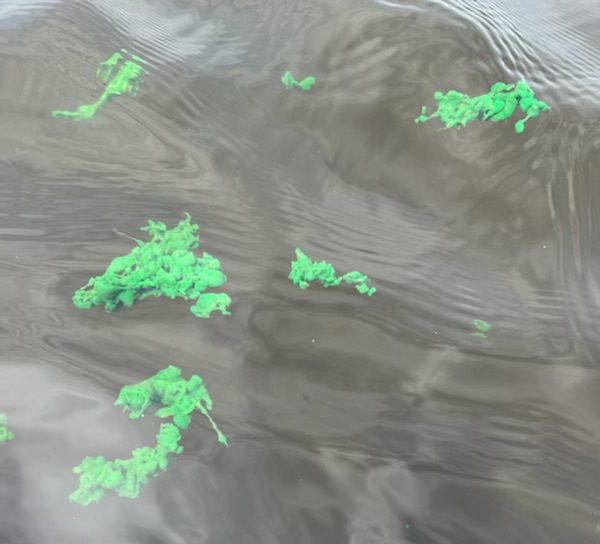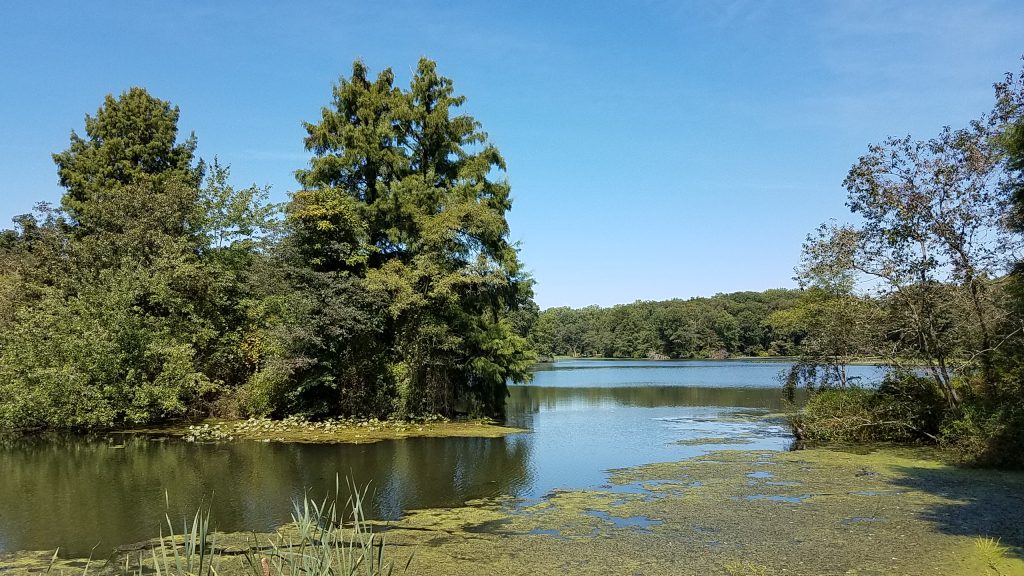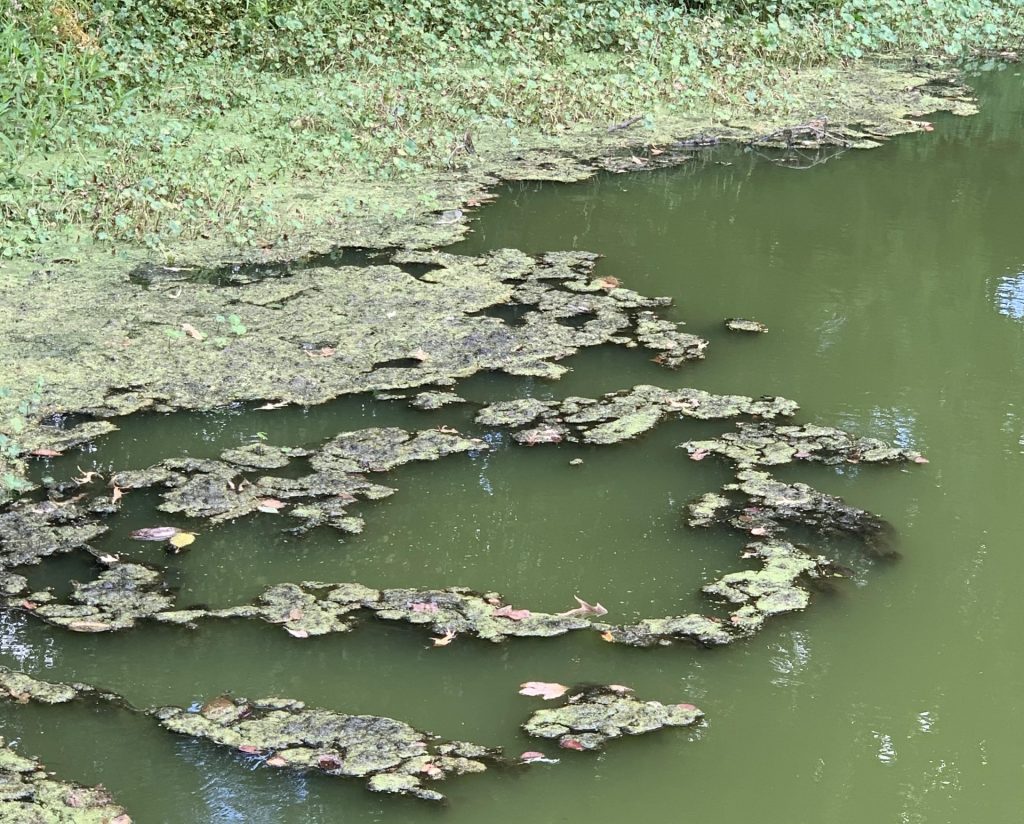
Wye Mills Lake 2024 boat ramp. Accumulation of Microseira mats (floating and within vegetation) that contained saxitoxin.The bright green color on top of mats are small floating plants (duckweed and watermeal). Also note the green colored water which was due to a planktonic algae, Microcystis, bloom that produced microcystin and led to a no-contact advisory being placed on the waterbody. DNR photo
As summer has begun, Maryland Department of Natural Resources scientists caution the public to be vigilant about freshwater algae mats that can sometimes be a health hazard for dogs and other animals.
Benthic algae mats are accumulations of algae that can vary in structure and appearance, but are often dense, green, and fibrous. Benthic cyanobacteria mats grow in both flowing and standing water such as rivers, creeks, reservoirs, lakes, and ponds, where they adhere to submerged rocks, plants, sand, shells, wood, and banks. Mats can also detach and float on the water surface, accumulate in eddies, or wash up on shore.
Not all benthic algae mats are toxic, but mats containing toxins have been found in Maryland waters over the past two years. Mats containing toxins are harmful when ingested, therefore scientists urge dog owners to keep their dogs out of the water when potentially harmful mats are present. Mats can be green, yellow, brown, or black. There is no way to determine if a mat is toxic just by looking at it; lab analysis is required.
Some benthic algae mats (those containing cyanobacteria) can produce potent neurotoxins including saxitoxin and anatoxin-a. Deaths from anatoxin-a exposure have been reported in dogs, cattle, bats, flamingos, waterfowl, and carp. Dog deaths from anatoxin-a have occurred in over 20 states. Some algal mats can also produce a liver toxin, microcystin, that has resulted in canine mortalities in Maryland. Dogs are most susceptible and can be exposed by drinking from natural waterbodies, eating algae mats, and grooming their fur and paws after swimming.
Exposure to cyanotoxins generally comes when an individual or pet comes into direct contact with a mat through skin contact or ingestion. Since adults are not likely to eat algae mats, the risk is low. On the other hand, dogs and children are more likely to come in contact with mat material. Dogs and other animals may be attracted to the musty smell and purposefully seek out and eat mats.
If ingested, neurotoxins can harm the nervous system. At low to moderate exposure levels, anatoxin causes neurological symptoms including muscle twitching, tingling, numbness, salivation, and loss of balance. At high doses, anatoxin may cause rapid death from respiratory system paralysis. Currently there are no national thresholds for either of these toxins in recreational waters in the U.S.
Protect Your Pets
Concentrations of blue-green algae will vary throughout the course of the year, but the blooms are most abundant during the mid to late summer when the weather is hottest. To protect pets, owners should:
- Bring plenty of water for pets to drink. Do not let your pet drink from natural waterbodies.
- Avoid areas where the water appears green, scummy, or has unavoidable benthic mats present.
- Keep pets on leash while hiking near freshwater bodies to avoid consumption of algae.
- Rinse themselves and pets with tap water right after going in the water.
Dogs that experience tremors or difficulty breathing should immediately be taken to a veterinarian or local emergency animal hospital.
In recent years, neurotoxin-producing benthic mats have been detected in the upper Chesapeake Bay (in the Susquehanna Flats and the North East River), the Potomac River, and in 15 Maryland lakes. As a result of toxin detection in 2023, DNR issued the first pet health caution alert on the non-tidal Potomac River, spanning 17 miles. In 2024, another pet health alert was issued for about 54 miles of the river.
Toxic algae cannot be identified just by looking at it. The DNR website provides images of benthic mats at the end of this article to help identify potential risks. DNR reminds people and their animals: when in doubt, keep pets out.
Monitoring Algae Mats
DNR Resource Assessment Service biologists routinely monitor algae across the Chesapeake Bay, Maryland’s Atlantic coast, and in 12 state-owned lakes. The Maryland Department of the Environment laboratory tests for the presence of anatoxins, while an outside lab determines the presence of saxitoxins.
DNR and other state agencies also monitor for harmful algal blooms in the water, which are a separate occurrence from benthic algae mats. These blooms can turn the water green or reddish brown and may also produce toxins. Maryland does not currently have an active Harmful Algal Bloom (HAB) surveillance program for benthic algae. Rather, the state has a response-based program triggered by reports of suspected benthic HABs from the public and/or field observations made by state agency staff. The Maryland Department of Health, Maryland Department of the Environment, and Maryland Department of Natural Resources coordinate responses to suspected benthic HAB events.
Toxin production and exposure risk from toxin-producing benthic mats are the subject of ongoing research in the U.S. and Maryland. High coverage of benthic cyanobacteria increases the likelihood of recreational users coming into contact with mats and potential toxins. Individuals who believe they may be experiencing symptoms of exposure should contact the Maryland Poison Control Center at 1-800-222-1222.
Cathy Wazniak, DNR’s environmental program manager who oversees algae monitoring, noted that benthic algae mats are still being studied and may be more prevalent in the area than previously realized. Recent data collected as part of an Environmental Protection Agency benthic mat project revealed the presence of cyanotoxins in the Patapsco and Patuxent rivers.
DNR and MDE asks residents to report potential algal blooms. Citizens can use a free mobile app called bloomWatch to report freshwater blooms nationwide, report online at DNR’s Eyes on the Bay website, or call Maryland’s Fish Health Hotline # 866-633-4686.
People and pets should stay away from benthic mats when present, and people can take steps to reduce nutrient pollution to help prevent harmful algal blooms.

Smithville Lake in 2019. Mixed benthic cyanobacteria mat floating near shoreline in foreground and mixed in the lily pads.
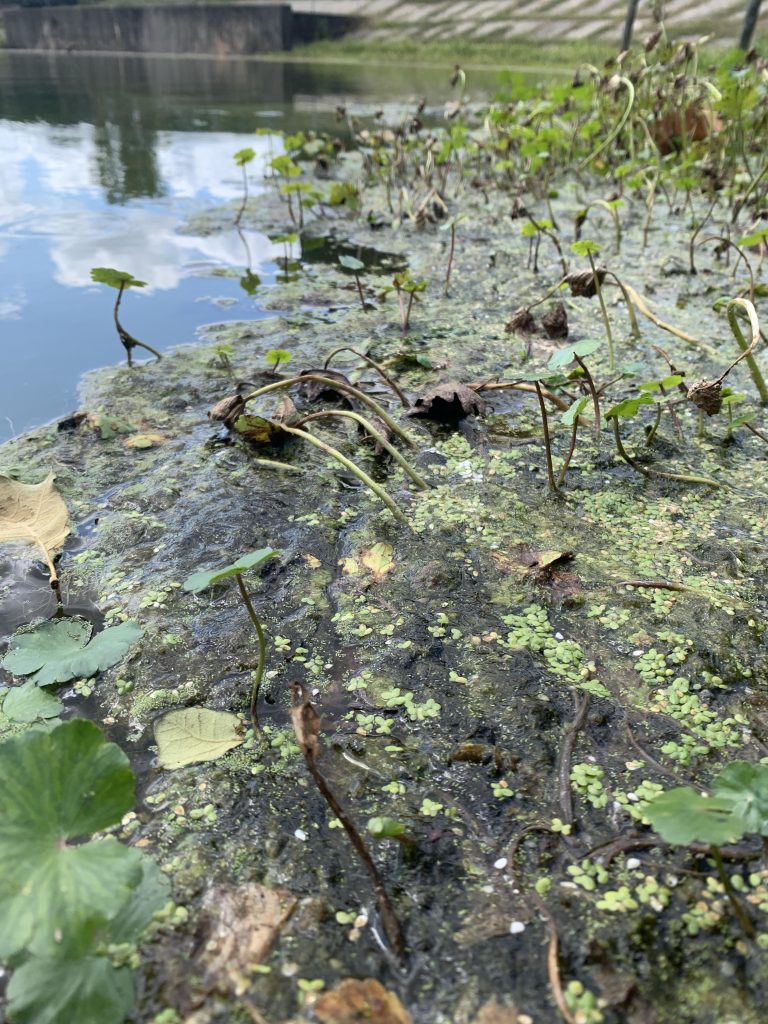
Wye Mills Lake dock, Microseira in wetland plants. Note the presence of bright green duckweed and tiny watermeal floating plants on top.
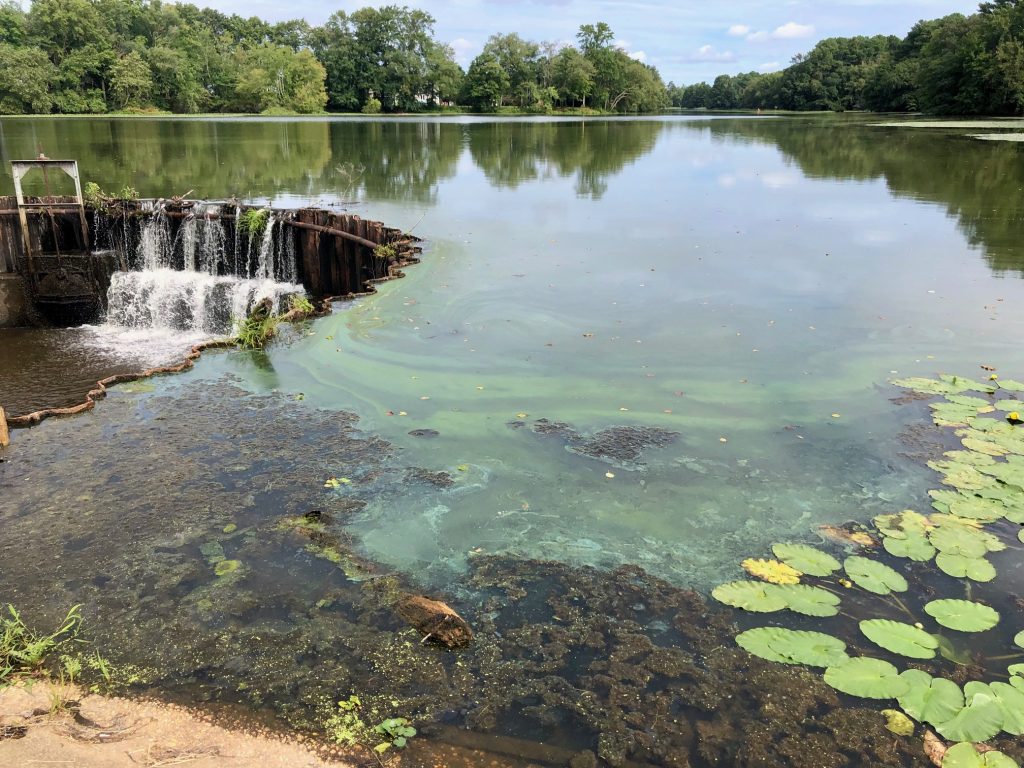
Smithville Lake with water bloom(yellow-green water middle/left of photo) and benthic mats along shoreline (right and foreground).
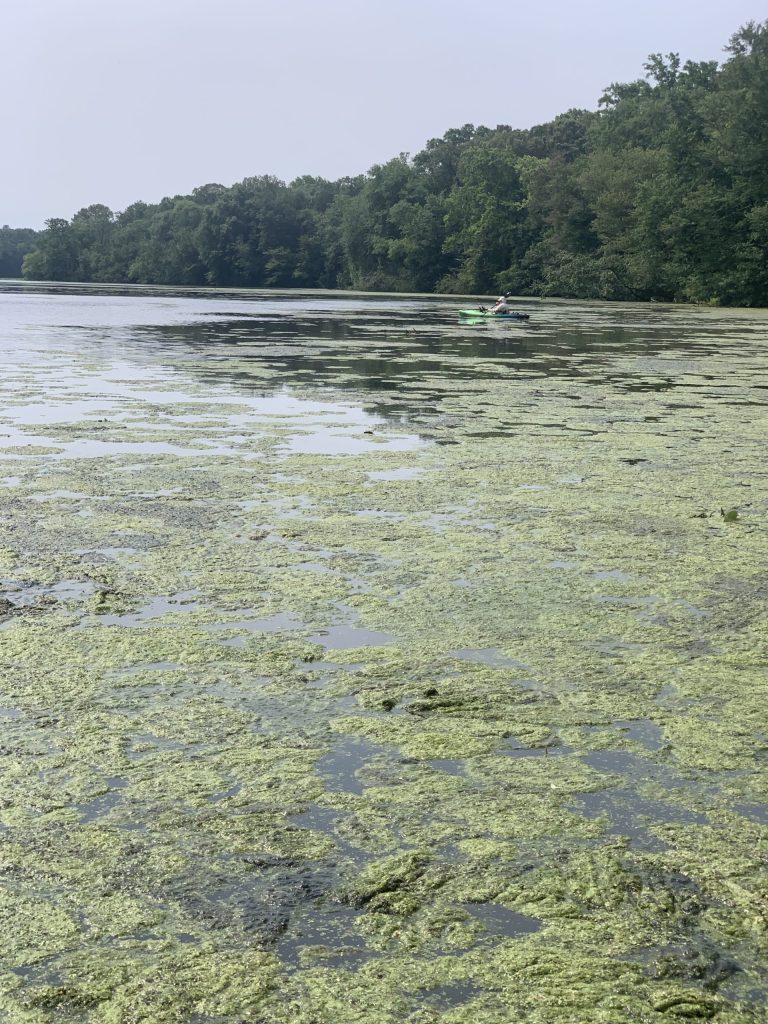
Unicorn Lake June 2025. Mix of cyanobacteria and green mats with Duckweed and Watermeal on top (the bright green).

Unicorn Lake Fishing Pier, June 2025. Mix of cyanobacteria and green mats with Duckweed and Watermeal on top (the bright green).


